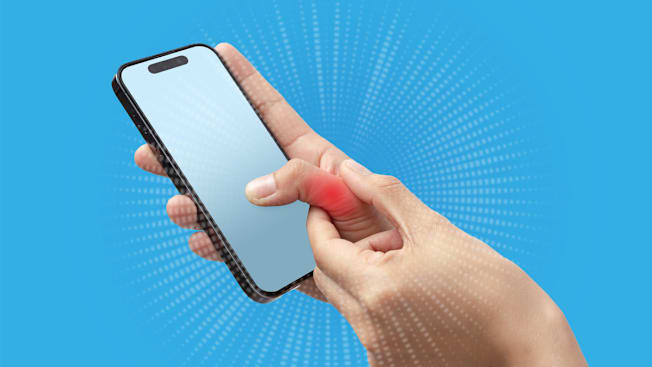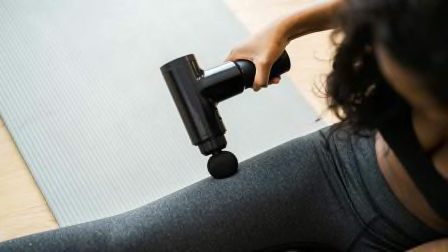Yes, Your Smartphone Can Cause Hand Pain
Here’s why, and what you can do to alleviate it

The symptoms started last year. I noticed a dull ache in my hand when I held my phone, and my fingers would stiffen when I typed. When the symptoms spread to other areas of my life—for instance, when I couldn’t hold my chopsticks as firmly as before—I began to suspect I had a problem.
How Phone Use Can Affect Your Body
Duretti Fufa, MD, a hand and upper extremity surgeon at the Hospital for Special Surgery in New York City, confirms that using a smartphone for too long can lead to pain, tendonitis, and pinched nerves in your fingers, hands, and elbows. If you already have joint problems such as arthritis or tendon and nerve conditions like carpal tunnel syndrome and tendonitis, you’re more prone to experiencing negative effects.
Repetitive movements such as tapping on your screen to text or play games can also increase discomfort in your thumb and forearm, says Paul Ritchey, DrPH, an ergonomist at Consumer Reports.
Neck and shoulder pain are also common. Dana Keester, MS, another CR ergonomist, says neck discomfort can stem from the looking-down posture most people adopt when using their phones, which puts excessive stress on the muscles that support the neck. What can also cause discomfort in your shoulders and neck is holding your phone up to your ear for a sustained period of time while making a phone call.
You might also feel pain in your lower back if you’re using your phone and sitting for a long time in an unsupported posture—if you’re slouched in your chair, for instance. And though we’re focused here on musculoskeletal pain, using your smartphone for too long (especially in a dark room) can cause eyestrain, Ritchey says.
How to Prevent Pain
To mitigate pain, you need to pay attention to both how long you’re using your phone and how you’re using it—in other words, your posture. Experts suggest that these steps can help.
Take breaks. The most significant action you can take is to spend less time on your smartphone, Fufa says. You can achieve that by cutting down on excessive usage and taking breaks from your phone every 15 to 20 minutes.
Try not to use your phone in one static, prolonged position. “Your next posture is your best posture,” Ritchey says. When you’re on your phone, shift the way you’re holding the device so that your hand isn’t locked in one position for a sustained period. You can also try switching between your right and left hand or using two hands instead of just one when holding your phone.
Stretching in between using your phone can help prevent skeletal muscular discomfort. One of the stretches Ritchey recommends is the wrist flexion and extension stretch: With your arm fully extended, rotate your palm so that it’s facing up and gently pull your hand toward you for about 15 seconds. Then turn your hand over so your palm is facing down and gently pull your hand toward you for about 15 seconds, and repeat this exercise two to three times. Ritchey says it’s also helpful to walk around and shake any body parts you were using while on your phone.
Adopt the right posture. A 2024 study published in the Journal of Back and Musculoskeletal Rehabilitation found that there’s a connection between the angle of your wrist and elbow when you’re using your smartphone and pain and discomfort.
To avoid nerve pain, Fufa says to make sure you keep your wrist in a straight, neutral position when you’re holding your phone. Bending or flexing your wrist could contribute to pinched nerve pains.
When possible, engage the larger groups of muscles in your arm because they’re less likely to tire, Ritchey suggests. For instance, when you’re tapping your phone’s screen, try moving your whole hand instead of flexing and tapping with just your fingers.
Go smaller and lighter. The weight of your smartphone can also play a role in your pain. According to a 2024 study published in BMC Public Health, if your smartphone is heavier, you’re more likely to experience discomfort in your hand after prolonged use.
If you’re buying a new smartphone, opt for a device that’s smaller or lighter, Fufa says. That might be tricky, though, because phones have steadily been getting larger in recent years. If you want to avoid the biggest phones, steer clear of iPhone Max and Plus models, and Samsung’s Ultra models. The smallest smartphone recommended by CR is currently the 2022 iPhone SE. You can also find a small model by sorting phones by their screen size in our cell phone ratings.
But if you’re not likely to switch phones anytime soon, Keester suggests trying a phone grip like a PopSocket or a smartphone stand or mount.
Go hands-free. When you’re on a call, consider using the speaker phone option, earbuds, or a headset to eliminate the need to hold your phone up to your ear for a long period of time.
Another handy feature is voice-to-text, which eliminates the need to physically type on a phone, lowering the chance you’ll develop discomfort, Keester says.
Days after following some of these steps, my fingers felt less stiff. I try to remember to take breaks. I also make a concerted effort not to bend my wrist when I hold my phone, which has reduced the pain I used to feel in my wrist. I’m also taking tips from my colleague, reporter Courtney Lindwall, on how to reduce overall screen time. And it can work: This week my daily average screen time was 12 percent less than last week.




















